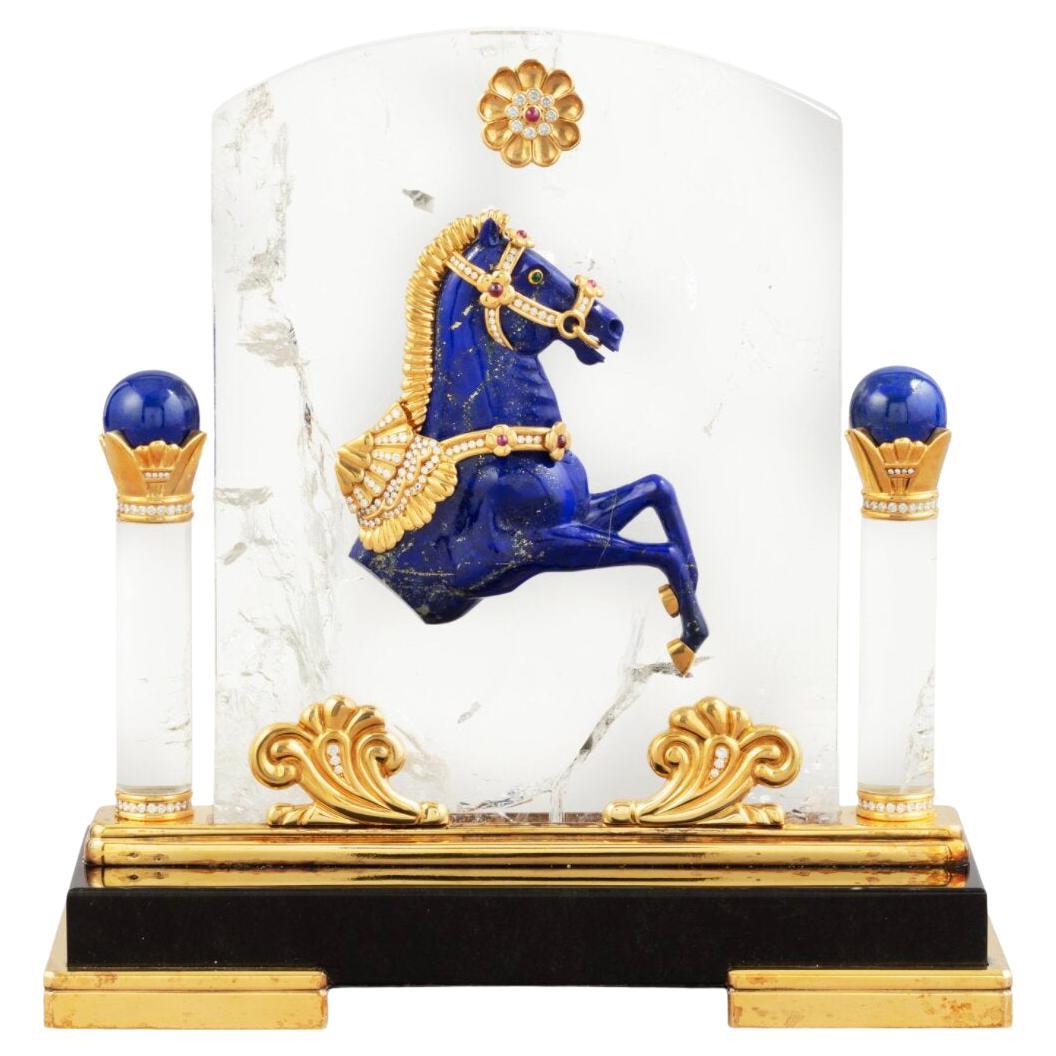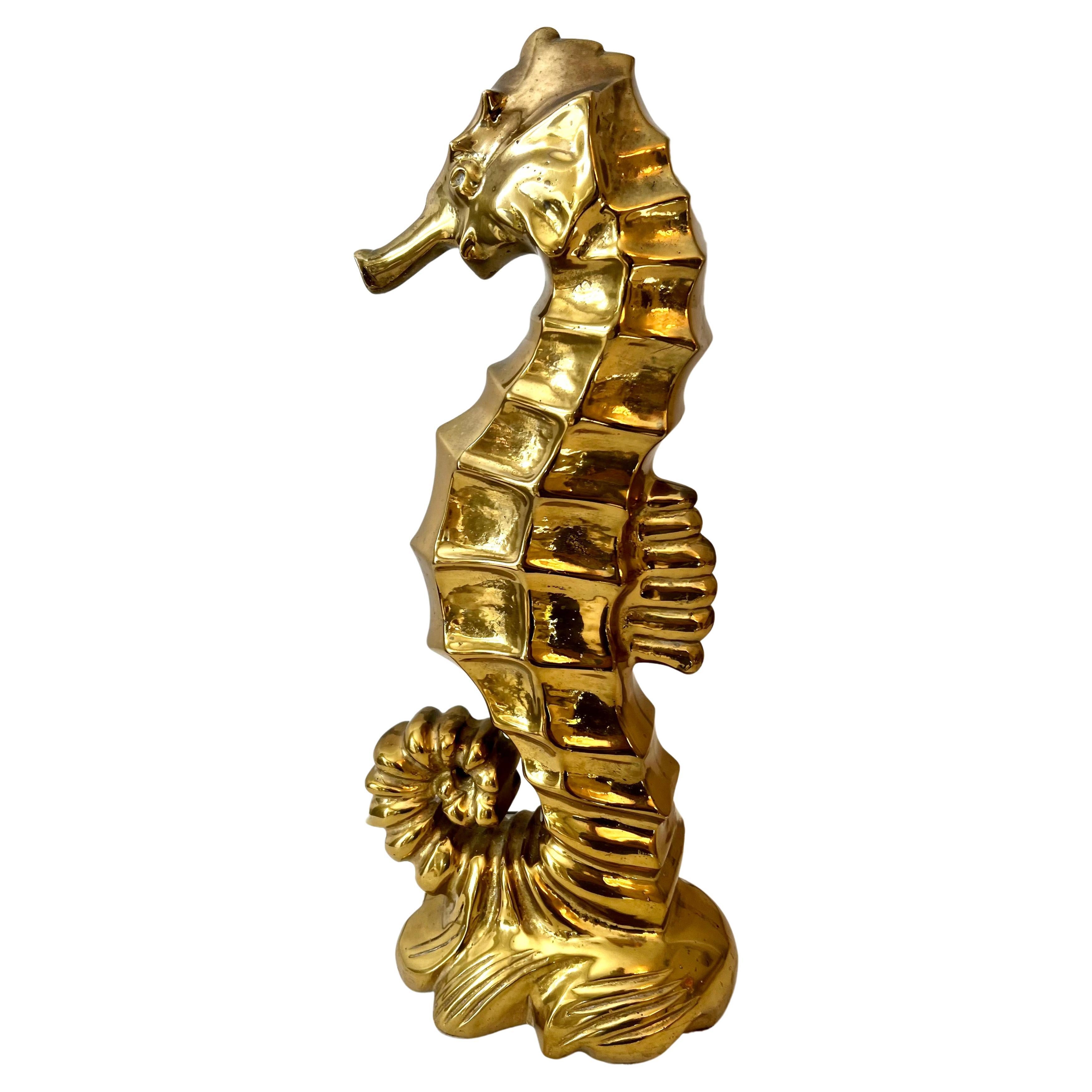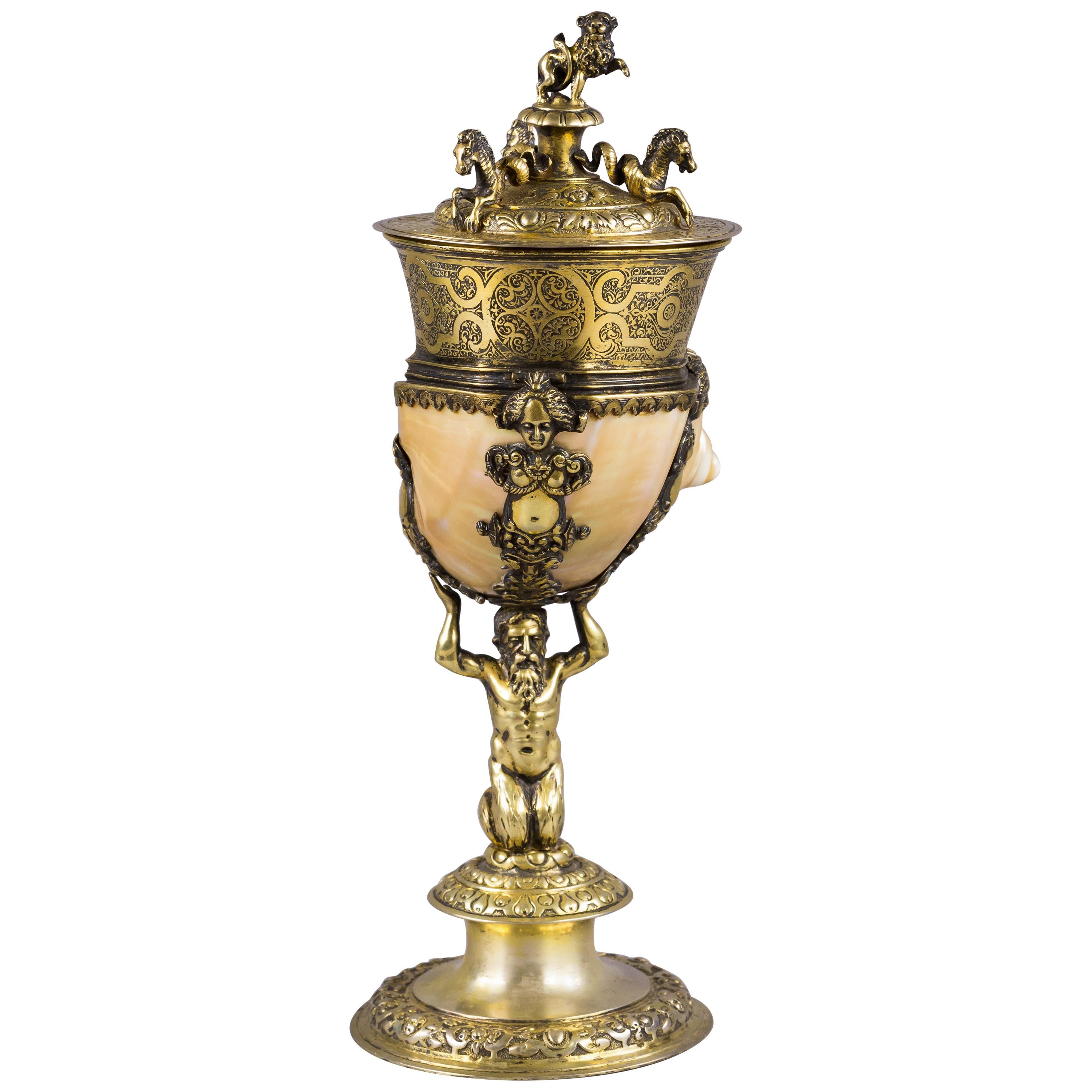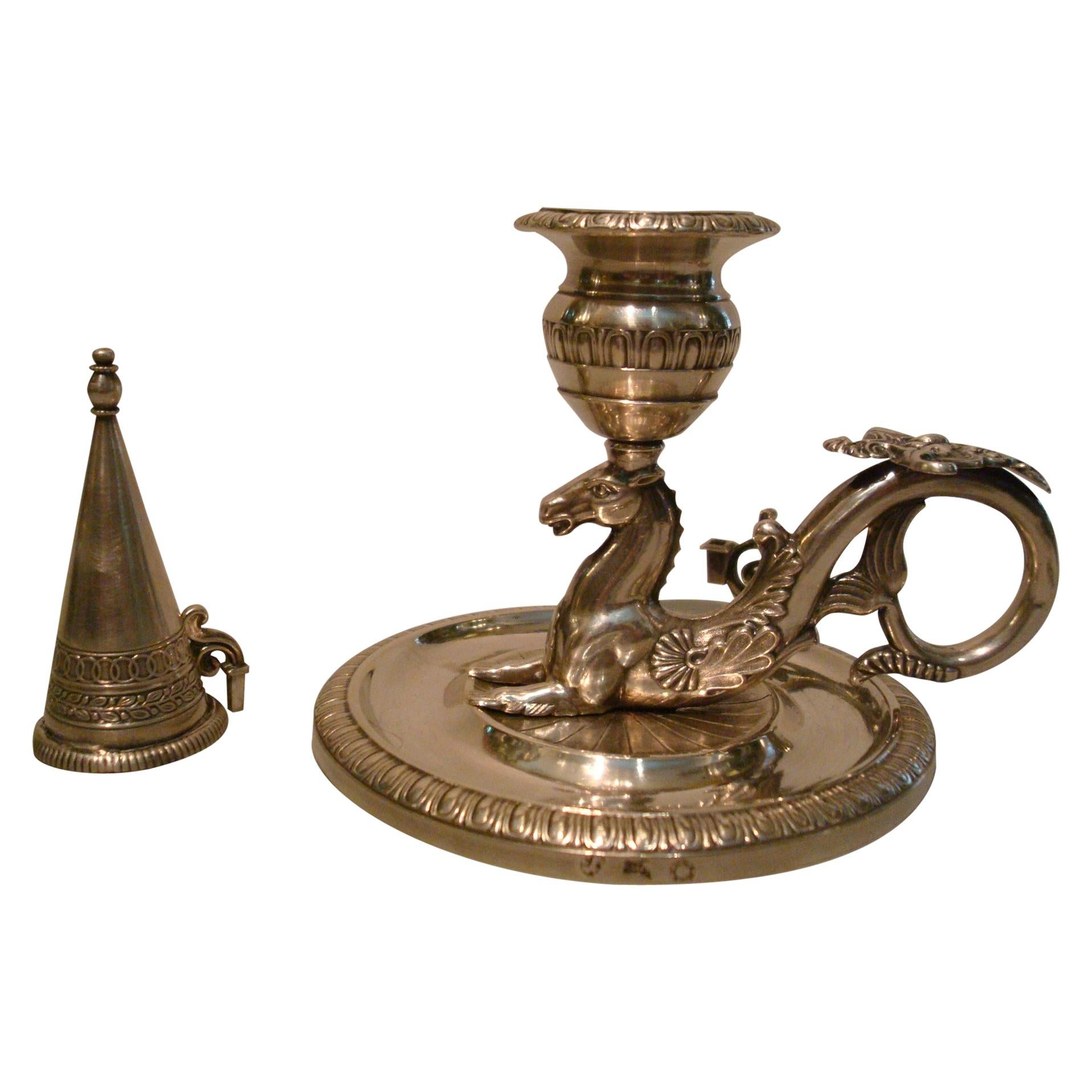Chaumet Paris, a French Silver-Gilt Seahorse Mounted Rhodochrosite Cup
About the Item
- Creator:Chaumet (Jeweler)
- Dimensions:Height: 7 in (17.78 cm)Width: 5.5 in (13.97 cm)Depth: 3 in (7.62 cm)
- Style:Brutalist (In the Style Of)
- Materials and Techniques:
- Place of Origin:
- Period:
- Date of Manufacture:circa 1980
- Condition:
- Seller Location:New York, NY
- Reference Number:1stDibs: LU1798227936832
Chaumet
Decades before luxury French jewelry maisons such as Van Cleef & Arpels and Cartier were born, Marie-Étienne Nitot (1750–1809) founded the house that became the internationally esteemed Chaumet, which, for centuries, has created timeless necklaces, watches, tiaras and other jewelry and accessories for royalty as well as Hollywood luminaries.
Before opening his own jewelry house, Nitot worked as an apprentice to Ange-Joseph Aubert, court jeweler to Marie Antoinette, and collaborated on pieces for the Queen. In 1780, he left Aubert’s side to open his own maison. Surviving the upheaval of the French Revolution, Nitot soon found lavish commissions with the new people in power. The Emperor Napoléon Bonaparte longed for France to once again be the epicenter of luxury, making himself the fashionable face of the prospering country. Nitot’s commissions for Napoléon began with the papal tiara for Pope Pius VII that included a 414-carat emerald among its thousands of precious stones and the 1804 coronation sword, a decadent piece that featured the 140-carat Regent diamond. The young jewelry house soon became the official jeweler of the Imperial Court, the personal jeweler of Empress Joséphine and one of the most sought-after jewelers in Europe. Chaumet’s work in this era helped popularize the tiara as a status symbol, with ornate pieces designed for Joséphine and Empress Marie-Louise, Napoléon’s second wife.
After Nitot died in 1809, his son, François-Regnault, took over in 1812 and moved the maison into the Place Vendôme, making it the first business to occupy the Parisian center of luxury. By then, Chaumet had included timepieces in its offerings, such as bracelet watches adorned with precious gemstones and equipped with movements made by Breguet (which opened a shop on Place Vendôme in 1933).
After the fall of the Napoléon Empire, successors Jean-Baptiste and Jules Fossin focused more on romantic styles of jewelry that referenced the past and nature, an approach carried on by Valentin and Prosper Morel. It was Joseph Chaumet, director from 1885 to 1928, who gave the maison its illustrious name and brought it into the 20th century with jewelry, accessories and tiaras inspired by the extravagant decor of the Belle Époque. Later, with Joseph’s son, Marcel Chaumet, succeeding him, the house would be featured at the Exposition Internationale des Arts Décoratifs et Industriels Modernes in Paris — from which the term Art Deco derives — and, alongside the likes of Cartier, would be seen as a leader in introducing the flamboyantly geometric designs and high-contrast color pairings of Art Deco jewelry to the global stage.
Chaumet has adapted over the years to meet changing tastes and trends. The house still reigns in the world of luxury jewelry, celebrating its 240th anniversary in 2020. Since 1999, it has been part of the LVMH Group. Its salons and high jewelry workshop continue to operate in the Place Vendôme where gem-setters, polishers and jewelers craft rings, earrings, watches and enduringly popular tiaras.
Find an exquisite range of authentic vintage Chaumet jewelry on 1stDibs.
- ShippingRetrieving quote...Ships From: New York, NY
- Return PolicyA return for this item may be initiated within 7 days of delivery.
- Mellerio Paris, A French Gold, Diamond, Silver-Gilt, Rock-Crystal, & Lapis HorseBy MellerioLocated in New York, NYMellerio Paris, A French Gold, Diamond, Silver-Gilt, Rock-Crystal, Obsidian & Lapis Horse An extremely rare and unique, one of a kind French gold, diamonds, Silver-gilt rock-crystal, obsidian and lapis lazuli jeweled sculpture "Bucéphale, Chevaux de légende", "Bucephalus, A Legendary Horse" by Mellerio, Paris, circa 1998. Sitting on black obsidian base, the solid rock crystal slab is finely applied with a lapis lazuli half-horse with harness mounted in 18k gold and brilliant cut diamonds, between two crystal and lapis lazuli columns adorned with gold and diamonds, insert with 7 ruby cabochons and 1 emerald cabochon, the obsidian base with a plaque engraved: CHEVAUX DE LEGENDE / MELLERIO DITS MELLER / PARIS / 5029 DIV Bucephalus (c355-326 BC) is among the most famous horses in history, and it was said that this he could not be tamed. The young Alexander the Great, of course, tamed him – and went on to ride his beloved equine companion for many years and into many battles. The piece is in excellent condition and comes with a custom made wood case made for transport. It's very elegant and has French hallmarks throughout. A truly magnificent piece. Measures 10" high x 9" wide x 4" deep Founded in France in 1613 by the descendants of Italian immigrants from the Vigezzo Valley in the north of Italy, Mellerio is one of the oldest jewellery houses in Europe. The family business soon attracted the attention of the Royal Court and Marie Antoinette herself reportedly purchased a precious bracelet featuring 7 cameos surrounded by rubies in 1780. Later on, in the 19th century, Mellerio became the official supplier of the French Royal family and the Court of Netherland. Mellerio creates many jewellery items, all set with rare gems such as peridots, amethysts, aquamarines, citrines and topaz, applying for a patent, the flexible stem, a very supple and light jewellery mechanism. Mellerio remains also well known for their spectacular series of Art Nouveau jewels, created at the beginning of the 20th century, as well as for the creation of trophies rewarding some of the greatest footfall and tennis players of history. In 1993, the jewellery house launched their first watch collection. Today, Mellerio has stores in Paris, Japan and Hong Kong. July 14, 1789: this date is known throughout the world as the beginning of the French Revolution. According to a ledger belonging to House of Mellerio, this was also the day that the jeweler sold a golden key to the Comte de Coutance for 10 livres. This ledger, as well as inventories dating as far back as 1768, are the jeweler’s oldest archives. These archives have continued to grow over the years, as the House, established on rue de la Paix in Paris, still lives on today, still in the hands of the same family from Craveggia, in the North of Italy. The tumultuous history of the Mellerio family in France probably goes as far back as the Italian wars of the Renaissance, but the first official document proving their commercial activity in Paris dates back to 1613. This document is the famous royal warrant awarded by Marie de Medici to a number of Italian families established along the rue des Lombards, including the Mellerios, allowing them to sell “small jewelery items”, therefore granting them a small exception to the traditional monopoly enjoyed by Parisian jewelers. At that time, powerful corporations regulated the operations and customs of Parisian business, but thanks to this exceptional warrant, the Mellerios managed to escape the confines of this framework. Today, this wax-sealed document is kept at the city hall of Craveggia. From 1613 to the Revolution, the Mellerios lived between France and Italy. The corporations tried many times to put an end to their trade privileges, but all in vain, as a dynasty of sovereigns renewed the warrant. Always marrying and often retiring in Craveggia, the Mellerios continued to maintain their jewelry business in Paris. At first, they did this without a shop. Wearing backpacks (wooden boxes divided into small compartments where jewels were kept), they would tour town fairs around Paris and royal castles. This is how Jean-Baptiste Mellerio (1765-1850) is said to have sold a bracelet set with rubies and Antique cameos to Marie-Antoinette, which still exists today. Many elements seem to prove the veracity of this anecdote. The queen was particularly fond of cameos, which cover the entire background of her famous jewelry cabinet, and ruby was her favorite stone after diamond. The famous bracelet, reacquired a few years ago by the House of Mellerio, is indeed an 18th century jewel, set with antique cameos representing the profiles of Roman emperors. Two branches of the family were operating in Paris during this time, under the reign of Louis XVI: that of Jean-François (1746-1828), the paternal ancestor of the current Mellerios, and that of Jean-Baptiste (1765-1850). The French Revolution forced them to return to Italy. However, both Jean-Baptiste and François Mellerio (1772-1843), who was the son of Jean-François, were eventually able to return to Paris after the founding of the Consulate. Jean-Baptiste opened a shop at the Iron Crown of rue Vivienne, and François opened his at the Palais des Tuileries, rue du Coq Saint-Honoré. His well-organized order books give an idea of his high-ranking clientele during the “Old Regime”, among which were the Comte and Comtesse Octave de Segur, the Marquise (later Duchess) de Tourzel, former governess of the royal children, and her daughter, the Comtesse de Bearn, the Craufurds -who organized the flight to Varennes, the Duc and Duchess de Gramont, the Comtesse de Boigne, and Madame de Souza, Talleyrand’s mistress. We also see the names of the imperial family: Empress Josephine, the Queen of Holland, Princess Elisa, Caroline and Pauline. At that time, the House of Mellerio specialized, among other things, in the trade of antique cameos, a newly fashionable genre of jewel that captured the imagination of all the princesses and noble women of the time. The years of the Restauration and July Monarchy were among the most glorious. The Bourbons were back on the throne, and the clientele of the House of Mellerio had regained its former wealth. Mellerio supplied Louis-Philippe, Duke of Orléans, as well as his mother, wife and sister, with sumptuous jewels, including a set of emeralds made piece by piece, while the Duke of Bourbon, last prince of the House of Condé, offered diamonds to his mistress, the scheming Baronne de Feucheres, and Monsieur de LaFayette also bought cameos for one of his granddaughters. For the first time, Mellerio ventured into the world of arts in 1815, when Carlotta Grisi, a famous dancer who created Giselle, as well as an actress named Rachel, bought jewels at the Mellerio store on rue de la Paix. 1848 marked a new turning point. France once again became a Republic. François Mellerio handed the company over to his son, Jean, and the latter decided to travel to Spain to build a new clientele. He later became one of the jewelers of the royal family, and met Eugénie de Montijo, who remained a faithful client when she became empress of the French people. The Imperial years were lavish. During the Second Empire, Paris was a pageant of crinoline dresses designed by Worth, while jewels by Mellerio, Worth’s neighbour on the rue de la Paix, adorned the noble women of the Tuileries court. The Empress bought pearls. Mathilde Bonaparte...Category
20th Century French Mounted Objects
MaterialsLapis Lazuli, Rock Crystal, Gold, Silver
- Mellerio Paris, A French Gold, Diamonds, Silver, and Smoky Quartz Carved HorseBy MellerioLocated in New York, NYMellerio Paris, A French Gold, Diamonds, Silver-Gilt, Rock-Crystal, Jade, Mother-Of-Pearl and Smoky Quartz, Carved Horse Sculpture, Jeweled Mounted Object. An extremely rare and unique, one of a kind French gold, diamonds, Silver-gilt, rock-crystal, jade, obsidian, mother-of-pearl, and smoky quartz carved jeweled sculpture "CHEVAUX DE LEGENDE", "A Legendary Horse" by Mellerio, Paris, circa 1991. Sitting on black obsidian base, the solid rock-crystal slab is finely applied with a carved smoky -quartz and jade horse with a harness mounted in 18k gold, brilliant -cut diamonds, rubies, turquoise, and amethyst chains and pendants. The top columns adorned with 18k gold and brilliant cut diamond pendants, the bottom with gold and mother of pearl plaques. The obsidian base with a plaque engraved: CHEVAUX DE LEGENDE" / N° 05 / MELLERIO DITS MELLER / PARIS / 5003 D The piece is in excellent condition and comes with a custom made wood case made for transport. It's very elegant and has French hallmarks throughout. A truly magnificent piece. Measures 10.5" high x 8.5" wide x 4" deep Founded in France in 1613 by the descendants of Italian immigrants from the Vigezzo Valley in the north of Italy, Mellerio is one of the oldest jewellery houses in Europe. The family business soon attracted the attention of the Royal Court and Marie Antoinette herself reportedly purchased a precious bracelet featuring 7 cameos surrounded by rubies in 1780. Later on, in the 19th century, Mellerio became the official supplier of the French Royal family and the Court of Netherland. Mellerio creates many jewellery items, all set with rare gems such as peridots, amethysts, aquamarines, citrines and topaz, applying for a patent, the flexible stem, a very supple and light jewellery mechanism. Mellerio remains also well known for their spectacular series of Art Nouveau jewels, created at the beginning of the 20th century, as well as for the creation of trophies rewarding some of the greatest footfall and tennis players of history. In 1993, the jewellery house launched their first watch collection. Today, Mellerio has stores in Paris, Japan and Hong Kong. July 14, 1789: this date is known throughout the world as the beginning of the French Revolution. According to a ledger belonging to House of Mellerio, this was also the day that the jeweler sold a golden key to the Comte de Coutance for 10 livres. This ledger, as well as inventories dating as far back as 1768, are the jeweler’s oldest archives. These archives have continued to grow over the years, as the House, established on rue de la Paix in Paris, still lives on today, still in the hands of the same family from Craveggia, in the North of Italy. The tumultuous history of the Mellerio family in France probably goes as far back as the Italian wars of the Renaissance, but the first official document proving their commercial activity in Paris dates back to 1613. This document is the famous royal warrant awarded by Marie de Medici to a number of Italian families established along the rue des Lombards, including the Mellerios, allowing them to sell “small jewelery items”, therefore granting them a small exception to the traditional monopoly enjoyed by Parisian jewelers. At that time, powerful corporations regulated the operations and customs of Parisian business, but thanks to this exceptional warrant, the Mellerios managed to escape the confines of this framework. Today, this wax-sealed document is kept at the city hall of Craveggia. From 1613 to the Revolution, the Mellerios lived between France and Italy. The corporations tried many times to put an end to their trade privileges, but all in vain, as a dynasty of sovereigns renewed the warrant. Always marrying and often retiring in Craveggia, the Mellerios continued to maintain their jewelry business in Paris. At first, they did this without a shop. Wearing backpacks (wooden boxes divided into small compartments where jewels were kept), they would tour town fairs around Paris and royal castles. This is how Jean-Baptiste Mellerio (1765-1850) is said to have sold a bracelet set with rubies and Antique cameos to Marie-Antoinette, which still exists today. Many elements seem to prove the veracity of this anecdote. The queen was particularly fond of cameos, which cover the entire background of her famous jewelry cabinet, and ruby was her favorite stone after diamond. The famous bracelet, reacquired a few years ago by the House of Mellerio, is indeed an 18th century jewel, set with antique cameos representing the profiles of Roman emperors. Two branches of the family were operating in Paris during this time, under the reign of Louis XVI: that of Jean-François (1746-1828), the paternal ancestor of the current Mellerios, and that of Jean-Baptiste (1765-1850). The French Revolution forced them to return to Italy. However, both Jean-Baptiste and François Mellerio (1772-1843), who was the son of Jean-François, were eventually able to return to Paris after the founding of the Consulate. Jean-Baptiste opened a shop at the Iron Crown of rue Vivienne, and François opened his at the Palais des Tuileries, rue du Coq Saint-Honoré. His well-organized order books give an idea of his high-ranking clientele during the “Old Regime”, among which were the Comte and Comtesse Octave de Segur, the Marquise (later Duchess) de Tourzel, former governess of the royal children, and her daughter, the Comtesse de Bearn, the Craufurds -who organized the flight to Varennes, the Duc and Duchess de Gramont, the Comtesse de Boigne, and Madame de Souza, Talleyrand’s mistress. We also see the names of the imperial family: Empress Josephine, the Queen of Holland, Princess Elisa, Caroline and Pauline. At that time, the House of Mellerio specialized, among other things, in the trade of antique cameos, a newly fashionable genre of jewel that captured the imagination of all the princesses and noble women of the time. The years of the Restauration and July Monarchy were among the most glorious. The Bourbons were back on the throne, and the clientele of the House of Mellerio had regained its former wealth. Mellerio supplied Louis-Philippe, Duke of Orléans, as well as his mother, wife and sister, with sumptuous jewels, including a set of emeralds made piece by piece, while the Duke of Bourbon, last prince of the House of Condé, offered diamonds to his mistress, the scheming Baronne de Feucheres, and Monsieur de LaFayette also bought cameos for one of his granddaughters. For the first time, Mellerio ventured into the world of arts in 1815, when Carlotta Grisi, a famous dancer who created Giselle, as well as an actress named Rachel, bought jewels at the Mellerio store on rue de la Paix. 1848 marked a new turning point. France once again became a Republic. François Mellerio handed the company over to his son, Jean, and the latter decided to travel to Spain to build a new clientele. He later became one of the jewelers of the royal family, and met Eugénie de Montijo, who remained a faithful client when she became empress of the French people. The Imperial years were lavish. During the Second Empire, Paris was a pageant of crinoline dresses designed by Worth, while jewels by Mellerio, Worth’s neighbour on the rue de la Paix, adorned the noble women of the Tuileries court. The Empress bought pearls. Mathilde Bonaparte...Category
20th Century French Mounted Objects
MaterialsJade, Quartz, Rock Crystal, Gold, Silver
- Exquisite Italian Silver-Gilt, Diamond, Rock Crystal, & Rhodochrosite MirrorLocated in New York, NYAn Exquisite Italian Silver-Gilt, Diamond, Rock Crystal, and Rhodochrosite Vanity Mirror, by Moba Italy. Circa 1950 Very fine and impressive vanity mirror made in solid sterling gi...Category
20th Century Italian Table Mirrors
MaterialsRock Crystal, Silver
- Mellerio Paris, a Silver, Gold, Lapis Lazuli, Coral, and Hardstone Picture FrameBy MellerioLocated in New York, NYMellerio Paris, a large silver, gold, lapis lazuli, coral, and hardstone picture photo frame with two falcons. France, circa 2000 The frame resting on a lapis lazuli base with squa...Category
21st Century and Contemporary French Picture Frames
MaterialsCoral, Lapis Lazuli, Silver
- Monumental Silvered and Gilt-Bronze Glass Centerpiece of "Poseidon"Located in New York, NYA Monumental French Silvered and Gilt-Bronze and Glass Centerpiece of "Poseidon", Paris, circa 1895. A very good quality centerpiece depicting "Poseidon and his seahorses", of mon...Category
Early 20th Century French Classical Greek Centerpieces
MaterialsBronze
- An Exquisite and Rare French Louis XVI Style Ormolu-Mounted Bloodstone InkwellLocated in New York, NYAn Exquisite and Rare French Louis XVI Style Ormolu-Mounted Bloodstone Inkwell, circa 1875. A truly exceptional and jewel like quality inkwell encrier, made with the finest ormolu, mounted on bloodstone. A true collectors and one of a kind piece. Revival of the ancient régime in the late 19th century was paramount to the French furniture and bronze casting firms of the Belle Epoque. Imitation in the highest regard and replication of those tastes and styles was prevalent throughout the Paris Faubourg, where the most talented bronziers and ébénistes established their workshops. The present inkwell encrier recalls the late 18th century's obsession with hardstones - a taste expounded above all by the duc d'Aumont and, subsequently Marie-Antoinette. Such hardstone-mounted pieces, reminiscent of Renaissance schatzkammer objects, enjoyed a revived popularity at the end of the 18th century through the impetus of both the marchands-mercier and, more importantly, the hôtel des Menus-Plaisirs, where the duc d'Aumont himself established a workshop in 1770 specializing in the cutting and polishing of precious hardstones. This exceptional inkwell encrier, sumptuously-mounted with finely chased gilt-bronzes, incorporates a highly-prized material such as bloodstone. Sometimes called the Sunstone, the meaning of Bloodstone comes entangled in fascinating history. The Ancient Greeks held the Bloodstone as a gem with glorious powers. They referred to it as Heliotrope, which directly translates to Sunstone. It was believed to have heavenly healing powers gifted by the gods and most certainly when it came to healing all things related to the blood. Even as we move forward into the Middle Ages, the Bloodstone takes another mystical story under its wing. It was believed to be formed from Christ's blood. It was said that during the Crucifixion, a few red spots of his blood dripped...Category
Antique 19th Century French Napoleon III Inkwells
MaterialsBronze, Ormolu
- An Incredible Chaumet Paris Gold & Diamond Mounted Carved Agate BowlBy ChaumetLocated in New York, NYAn Incredible and Rare Chaumet Paris Gold & Diamond Mounted Hand-Carved Agate Bowl, with 18K gold Stamp, as well as, Makers Stamp. An exquisite hand-carved and hand-polished banded agate bowl...Category
Vintage 1960s French Other Decorative Bowls
MaterialsAgate, Gold
- Gilt Over Bronze Seahorse Door Stop or SculptureLocated in Los Angeles, CADecorative Sculpture of a seahorse - Gold over bronze. A stunning piece for the centerpiece of a table or room, or an addition to a seaside story in the garden or living space. Th...Category
20th Century Mid-Century Modern Animal Sculptures
MaterialsGold Plate, Bronze
- German Silver Gilt and Shell Covered Nautilus Cup, circa 1880Located in New York, NYWith a figure of Neptune holding aloft a beautiful iridescent shell enclosed by three strap-work figures. The cover surmounted by three sea horses and...Category
Antique 1880s Austrian Natural Specimens
MaterialsSilver
- Helmet Paperweight Mounted on a Piece of Marble Paris FranceLocated in Los Angeles, CAAcquired in Paris France, this is a wonderful paperweight. A Helmut mounted on a piece of marble - a compliment to any desk or work station. The helmet is metal and the sides move a bit, as they are supposed to. A great curiosity, wonderful for a housewarming or fathers day gift.Category
20th Century French Mid-Century Modern Paperweights
MaterialsMarble, Metal, Brass
- Silver Chamberstick / Candleholder Hippocampus / Seahorse, 1837 Munich, GermanyLocated in Buenos Aires, OlivosSilver Chamberstick / candleholder hippocampus / seahorse, circa 1837 Munich, Germany. This silver Chamberstick retain the original detachable snuffer.Category
Antique 1830s German Early Victorian Natural Specimens
MaterialsSterling Silver, Silver
- Rhodochrosite N’Chwaning MinesLocated in New York, NYRhodochrosite N’Chwaning Mines, Kuruman, Kalahari Manganese Field, Northern Cape, South Africa 2.6 cm tall x 4.4 cm wide The N'Chwaning Mine has produced many of the finest kn...Category
Antique 15th Century and Earlier South African Natural Specimens
MaterialsOther






